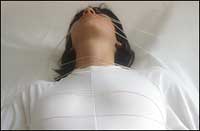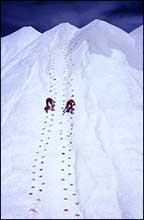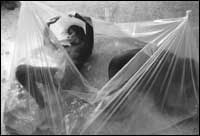![]()
Yeni & Nan. Duality, 1977 - 1986
Opening: February 14, at 20:00 h.
Dates: February 15 - June 9, 2019
Curator: Alicia Murría
Space: East Cloister
The efforts of recent decades to recover the work of important women
artists, forgotten or ignored by art history, not only do justice,
but also rewrite discourses formerly riddled with gaping holes that
made it difficult to properly understand the profound changes in
contemporary art.
The contribution of women artists to art theory
and practice, hand-in-hand with the feminist movement, has been
undeniable, especially since the late 1960s and 70s. The female
artists and theorists of those years started a quest
which is far from over.
The multidisciplinary work of Yeni & Nan is difficult to define because it draws on different trends, media and resources that began to converge in the 1960s and 70s: non-objective art and conceptual art, land art, body art, ephemeral art, action art and performance, installation and video installation, video and photography, drawing and text.
With the advent of video, women artists discovered a new media which, unlike painting and sculpture, did not have a history that might have excluded them from the narrative of art, an ideal vehicle for expressing equally new artistic experiences like action art and performance.
Yen & Nan used video to embark on an exploration of the body, of human beings in their relationship with nature and of the existential experience of space, seeing the individual as a whole. They devoted themselves to learning how to see the body—on a physical, mental and psychological level—in a brand-new way. They wanted to craft experiences, not objects.
Yeni & Nan met at the Cristóbal Rojas Art School in the capital of Venezuela and between 1977 and 1986, they shared a life and an artistic project that produced a pioneering brand of performance in Venezuela.
This exhibition is divided into five major sections: BIRTH, IDENTITY, WATER, EARTH and ARAYA.
The central theme of their production is the body—or, better said, their own bodies. They become objects, subjects and workspaces, always adopting a process-centred approach. That process is related to their understanding of creation as well as to the idea of change and growth on an artistic, but also psychological and personal, level.
Alicia Murría
ADDITIONAL DOCUMENTATION |
![Yeni & Nan. Simbolismo de la cristalización [Symbolism of Crystallization], 1984-86/2010. Courtesy Galería Henrique Faria Yeni & Nan. Simbolismo de la cristalización [Symbolism of Crystallization], 1984-86/2010. Courtesy Galería Henrique Faria](../../../img/expos/yyn01pqeng.jpg)


